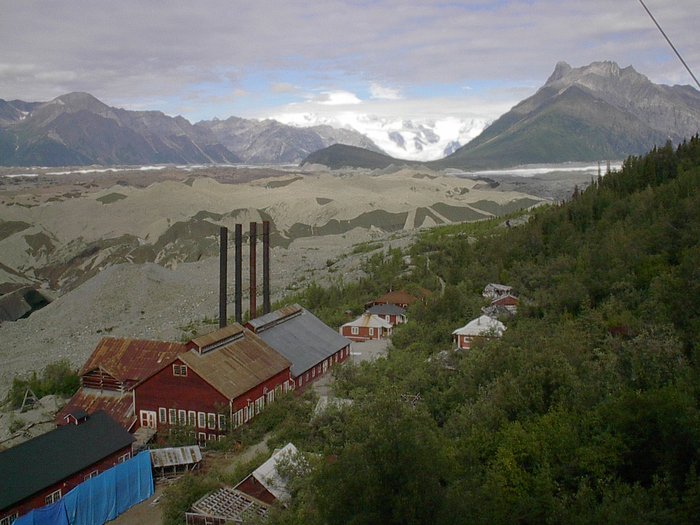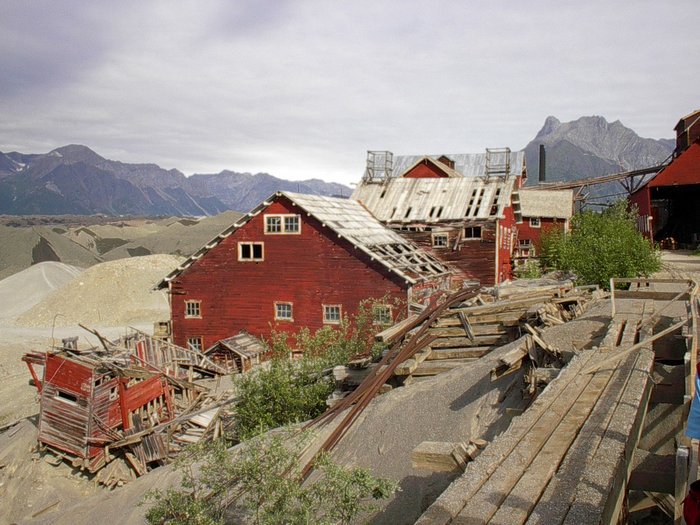
Summary
The Kennecott Copper Mine, for a time the largest copper mine in the world, operated from 1911 to 1938 in what is now Wrangell St. Elias National Park. The mine produced a total of around 4.6 million tons of ore, valued at over $200 million (~$3 billion in 2011 dollars). The Alaska Syndicate which formed to develop the mine, eventually expanded into coal, salmon, and infrastructure throughout the state. Their influence helped prevent Alaska from becoming a state as early as 1916 and played an important role in national politics as well.
History

This is the Kennecott Power House that provided power for many of the mill workings and the town of Kennecott. Right on the edge of town is the Kennicott Glacier
 — 
<a class="figure-caption__link" href="/photos/kennecott-power-house/">Get Photo</a></figcaption></figure>The first claims to what would become the Kennecott Mining Company were staked in 1900. Ore samples from this time contained up to 70% copper, making it one of the highest grade deposits in the world. The ore deposits were primarily composed of chalcocite which is known for its higher copper content and ease of refining. In addition to copper, a significant amount of silver and small amounts of gold came out of the mine. From 1901-1905 a variety of legal battles over the claims and company reorganizations took place. Eventually, J.P. Morgan and the Guggenheim family created the famous “Alaska Syndicate” to develop the mine and build related infrastructure. A 196-mile long railroad to transport the ore to Cordova and a steamship line between Cordova and Tacoma (Seattle) were developed, along with mining facilities and a town for the workers.
In 1911 the new railway transported its first load of copper ore. The mine operated until 1938, when the deposit was mostly exhausted and copper prices had fallen. During the time the mine was still in operation the Kennecott Mining Company had also developed other properties, and it still exists today (as part of Rio Tinto) and is involved in the proposed Pebble Mine.
During its heyday the Alaska Syndicate purchased other mines in the state, such as the Beatson Copper Mine, as well as numerous coal, fishing, and transportation interests. The political influence of the Syndicate was an important part of the Pinchot-Ballinger controversy, which helped to define the conservation movement at the start of the 20th century.
Mine site

The ammonia leach flotation process was pioneered in this building at the historic Kennecott Copper Mine. Modern mines use cyanide instead.
 — 
<a class="figure-caption__link" href="/photos/kennecott-leach-and-flotation-facility/">Get Photo</a></figcaption></figure>The mine and the towns of Kennecott and nearby McCarthy were all located within what is now Wrangell St-Elias National Park. Kennecott (a misspelling of the nearby Kennicott Glacier) consisted of mining infrastructure (mill, flotation plant, crushers, etc.) as well as a town for the miners and their families. The ore came from five separate mines up in the hills to the NE: Erie Mine, Jumbo Mine, Bonanza Mine, Mother Lode Mine, and Glacier Mine. A system of tramways moved ore between the sites and the town. At its peak the town had around 300 people, and an additional 200-300 miners lived at the mines. Much of the infrastructure still remains and the town of Kennecott has become a tourist destination within the park.
Comparison to Pebble Mine
The Kennecott mine had relatively few long-term environmental impacts for a mine of its size, and has been used by supporters of the proposed Pebble Mine as an example to follow. However, there are significant differences between the two sites.
Acid Mine Drainage
_
…Acid mine drainage is a major problem with many hardrock mines, including almost all mines where the metal ore is bound up with sulfur (metal sulfide mines)…
_
The copper deposit mined by Kennecott was very high grade and the copper sulfides were found in conjunction with carbonate minerals. These carbonate minerals reacted to neutralize acid mine drainage. The high grade of copper (average 13%) meant that relatively little waste was produced by the mine, especially since much of the rich ore was removed selectively by pickaxe. In contrast, the deposit at the proposed Pebble Mine is 2000 times the volume, doesn’t contain significant acid neutralization potential (i.e. carbonate minerals), and the average copper grade is only 0.34%.
Additionally, the Kennecott mine is situated in a setting where the deposit is rapidly eroding, so downstream waters are already exposed to the mineral material, and downstream ecosystems are adapted to sediment and runoff from the mined area. In contrast, the Pebble deposit is buried under surficial sediment in an area that is eroding very little, and so is insulated from the environment if no mining occurs.
Further Reading
- > National Park Service bulletin "The Kennecott Story"
- > National Park Service page on Kennecott Mine
- > National Park Service nomination form for Kennecott Mine to be added to the National Register of Historic Places (1987)
- > Wikipedia article on Kennecott
- > "Kennecott: Alaskan Origins of Copper Empire, 1900-1938" produced by the Western Historical Quarterly 1978 (behind a pay wall).
Created: Jan. 19, 2018